Configuring the LEADTOOLS Storage Server Application using the Control Panel: Administration
The Administration button opens the Server Settings dialog with the Administration branch selected in the tree view. It contains settings for who can log into the server, what permissions they have, what roles they have, as well as password, database manager, and anonymization options.
The image below shows the Storage Server Administration button:

The Administration branch can be expanded to show the following pages:
Each page is explained below.
Password Options page
The Password Options page displays those settings that determine the requirements of user passwords for logging onto the LEADTOOLS Storage Server.
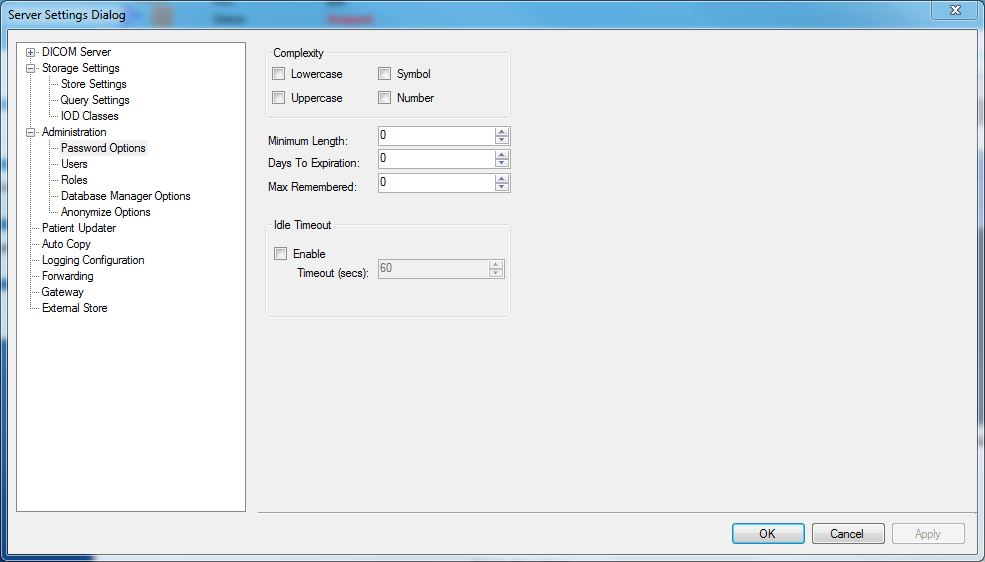
Complexity group
Use these options to specify which elements are required for a valid password.
-
Lowercase check box Select the check box to require passwords to have lowercase letters.
-
Uppercase check box Select the check box to require passwords to have uppercase letters.
-
Symbol check box Select the check box to require passwords to have symbols.
-
Number check box
Select the check box to require passwords to have numbers.
-
Minimum Length Sets the minimum length of a password.
-
Days to Expiration: Sets the number of days a user can keep a password before having to change it. After a password expires, the server requires the user to change the user's password before logging onto the server.
-
Max Remembered:
The number of tries a user has before being locked out.
- Idle Timeout group
Sets up the idle timeout feature, when used.
-
Enable check box Select the check box to use idle timeouts.
-
Timeout (secs) spin box. Sets the number of seconds a session can be idle before timing out. If the session times out, the user must re-enter their credentials.
Users page
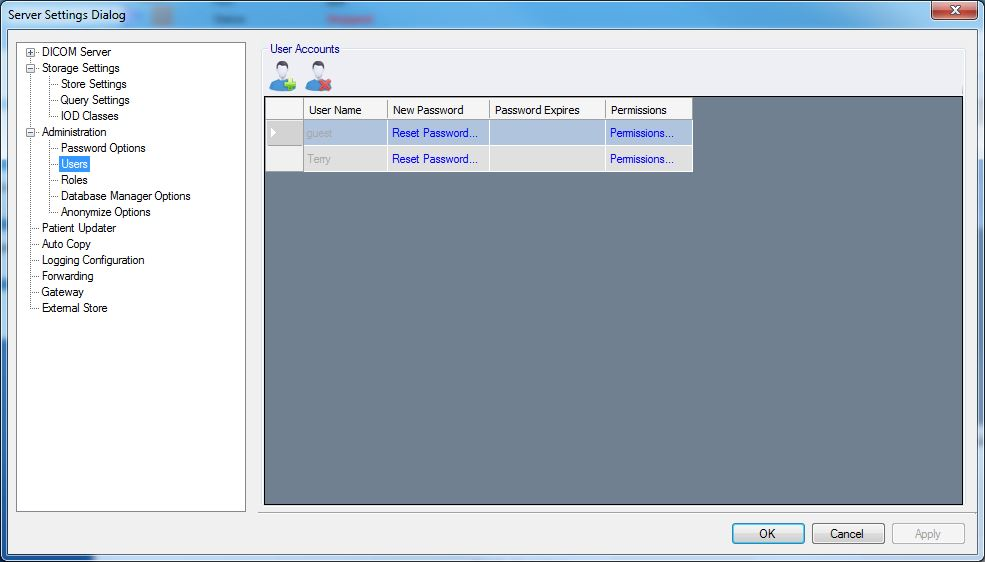
Use the Users page to set up user accounts. It is shown in the following figure.
The following fields are on the Users page:
Add User button

Click the Add User button to add users that can log into the LEADTOOLS Storage Server. Clicking the button adds a blank row to the User Accounts list view. The cursor moves to the User Name column in the new row so you can enter the new user's name.
Delete User button

If a user is selected in the list view, clicking the Delete User button deletes the selected user. You cannot delete yourself.
User Accounts list view
List view displaying information about the users that can log onto the server.
-
Set/Reset Password link Opens the New Password dialog for entering a new password and confirming it. Passwords must comply with the password requirements specified in the Password Options page.
-
Permissions link Click the Permissions link beside the new user name to open the Edit Permissions dialog to select the permissions that the user will have. When finished, click OK to close the dialog and return to the Server Settings Dialog. The new user account will now be active.
Roles Page
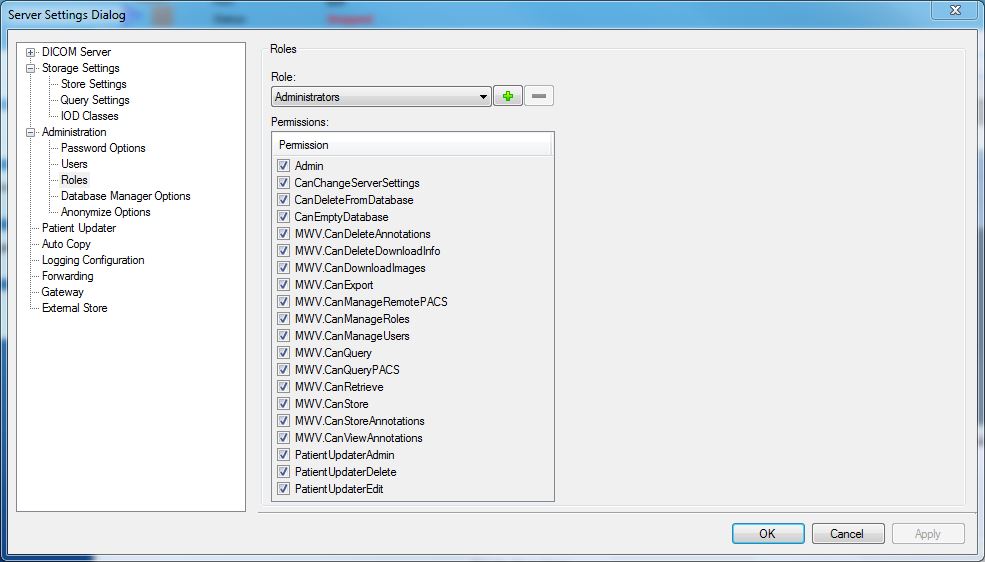
Use the Roles page to create new roles (groups of one or more permissions), and assign permissions to those roles. New or existing users can be assigned both permissions and roles.
The Roles page has the following fields:
Role Drop-Down List
This list contains all existing roles. By default, there is an Administrators role that contains all permissions.
Add Role Button
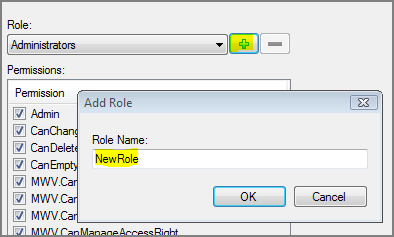
To create a new role, click the Add Role button and enter the name for the role.
Delete Role Button
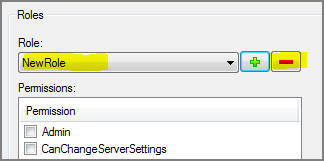
To remove a role, select the role in the role drop-down list and click the Delete Role button.
Permissions
This lists all permissions that can be assigned to a role. To assign a permission to a role, select the role in the role drop-down list, and select or clear the check boxes beside the appropriate permissions.
| Permission | Description |
|---|---|
| Admin | Allows a user to administer the Storage Server |
| CanChangeServerSettings | Allows a user to modify server settings. Does not include Patient Updater or image deletion privileges. |
| CanDeleteFromDatabase | Allows a user to delete from storage database. Grants deletions on a case-by-case basis (no mass deletions). |
| CanEmptyDatabase | Allows a user to empty the storage database. Grants deletion of the entire database. Only Administrators should have this permission, and should give themselves this permission only rarely. |
| MWV.CanDeleteAnnotations | Allows a Medical Web Viewer user to delete annotations. |
| MWV.CanDeleteDownloadInfo | Allows a Medical Web Viewer user to delete jobs in download queue. |
| MWV.CanDownloadImages | Allows a Medical Web Viewer user to Move images from a remote PACS. |
| MWV.CanManageAccessRight | Allows a Medical Web Viewer user to grant or deny access to patient information. |
| MWV.CanManageRoles | Allows a Medical Web Viewer user to manage other. |
| MWV.CanManageUsers | Allows a Medical Web Viewer user to manage other users. |
| MWV.CanQuery | Allows a Medical Web Viewer user to query local images. |
| MWV.CanQueryPACS | Allows a Medical Web Viewer user to query a remote PACS. |
| MWV.CanRetrieve | Allows a Medical Web Viewer user to request DICOM. |
| MWV.CanStore | Allows a Medical Web Viewer user to save DICOM Datasets |
| MWV.CanStoreAnnotations | Allows a Medical Web Viewer user to save annotations. |
| MWV.CanViewAnnotations | Allows a Medical Web Viewer user to load annotations. |
| PatientUpdaterAdmin | Allows a user to administer the Patient Updater. Grants administration privileges for the Patient Updater (image and Patient Updater options alterations). |
| PatientUpdaterDelete | Allows a user to delete from the Patient Updater. Grants the privilege to delete images using the Patient Updater. |
| PatientUpdaterEdit | Allows a user to make edits to the Patient Updater. Grants the privilege to edit images using the Patient Updater. |
Database Manager Options Page
The Database Manager Options page is shown in the following figure:
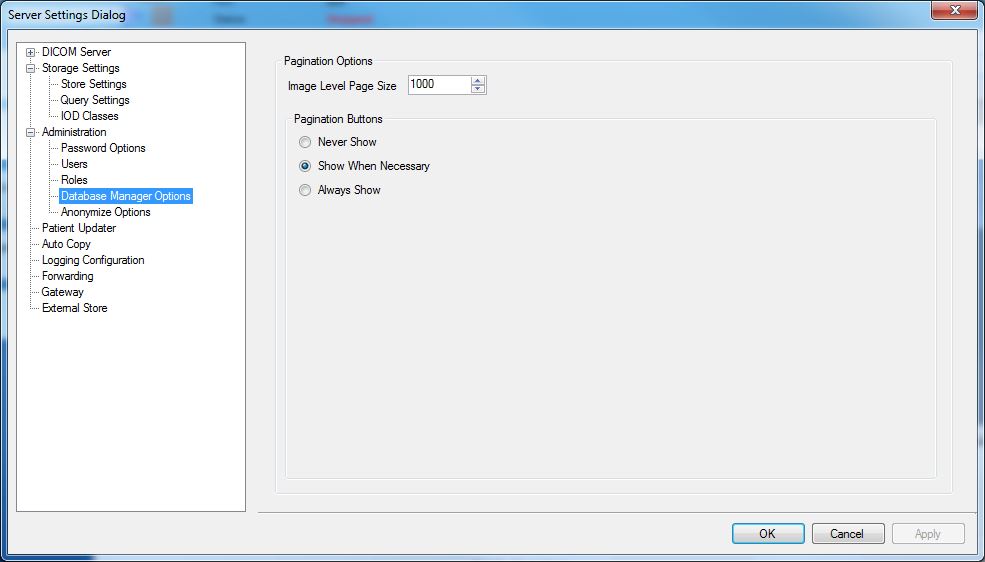
Use the Database Manager Options page to configure the behavior of the pagination control of the Database Manager, which is shown in the following figure:

The Database Manager Options page has the following fields:
Image Level Page Size
This is the maximum number of records displayed on a single page in the Database Manager. When Display is Image Level, all pages except the last one will contain exactly the specified number of records. The last page will contain the remainder. If Display is Patient Level, Study Level, or Series Level, then the number of records in each page can be less than the Image Level Page Size.
Pagination Buttons Group
Use these options to specify when the Database Manager will display the pagination control.
(The pagination control is on the Database Manager tab and is shown in the following figure:

To navigate between pages, click the arrows or select a page number and click Go to Page.)
The Pagination Buttons group on the Database Manager Options page has the following radio buttons:
-
Never Show Never display the pagination control.
-
Show When Necessary Display the pagination control only when necessary. For example, if the Image Level Page Size is 10 and there are 9 instances in the database, the pagination control would not be displayed because all instances fit on a single page. However, if there were 11 instances in the database, the pagination control would be displayed because all instances do not fit on a single page.
-
Always Show Always display the pagination control. With this option the pagination control would be displayed if the Image Level Page Size is 10 and there are 9 instances in the database.
As an example, suppose your database has a total number of 25 instances, and you set the Image Level Page Size to 10 and then click the Search button on the Database Manager. The search will produce three pages of records. The first and second pages each display ten records, and the last page displays five records. Click the arrows or the Go to Page button to navigate between pages.
Anonymize Options Page
The Anonymize Options page is shown in the following figure:
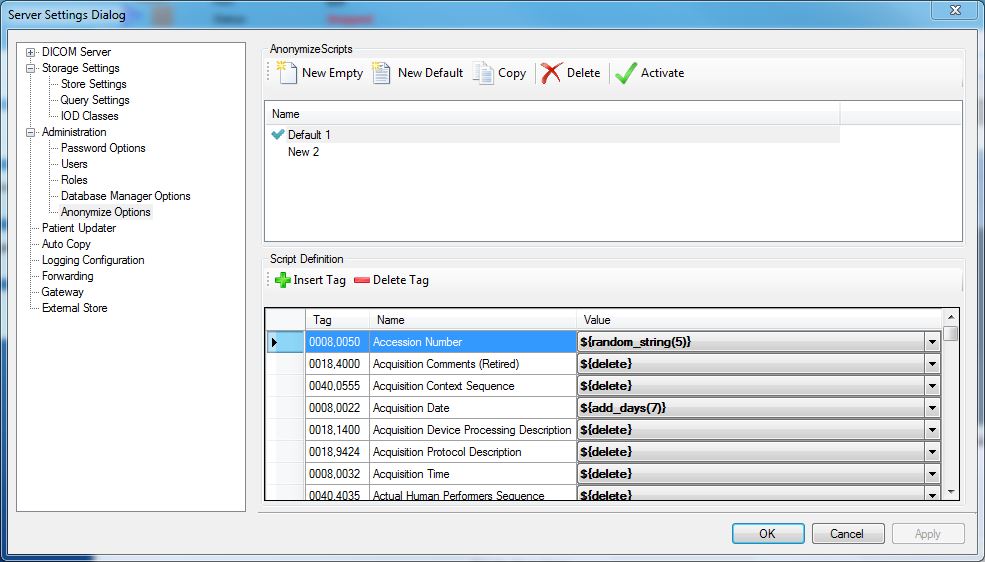
Use the Anonymize Options page to set up the anonymize scripts that can be used when exporting DICOM datasets from the Database Manager tab.
Anonymize Scripts Toolbar
At the top of the Anonymize Options page is an Anonymize Scripts toolbar, which has the following buttons:
-
New Empty Creates a new, empty script (the script contains no tags).
-
New Default Creates a new, default script. A default script is a set list of commonly used tags and typical default values. Default values specify how tags will be anonymized. Refer to the Anonymize Script Macros for a list of possible values.
-
Copy Makes a copy of the currently selected script. The new script's name is the same as the original, but with the word "Copy" appended to the name.
-
Delete Deletes the selected script.
-
Activate Makes the selected script the active script. The active script is the script used when exporting DICOM datasets and has a green check mark beside it. The active script selection persists after the session ends and is the active script the next time the application opens. The active script selection is used in the Export Selected dialog, as shown in the following figure:
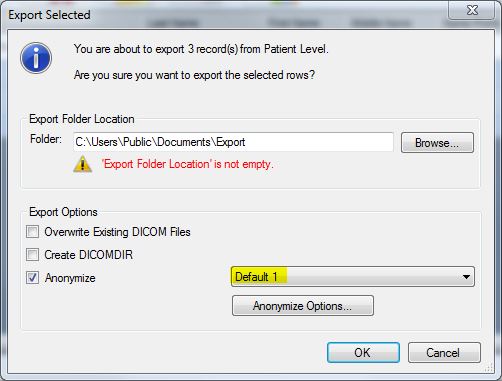
Anonymize Scripts Listview
Below the Anonymize Scripts toolbar is the Anonymize Scripts listview, which lists the currently existing anonymize scripts. Initially, there is one script: Default 1.
Note that initially on the Anonymize Options page the Default 1 script has a green check mark beside it. The green check mark indicates that it is the active anonymize script. The active anonymize script is the script selected in the Export Selected dialog. Any script can be made the active anonymize script simply by selecting it in the Anonymize Scripts list and clicking the Activate button on the Anonymize toolbar.
Script Definition Group
The bottom panel of the Anonymize Options page is the Script Definition Group. Use it to insert or delete tags to compose the desired script.
The following topics illustrate how to use the Storage Server export feature and anonymize patient information:
- Walkthrough 1 - Export Selected: Backing up existing patient information
- Walkthrough 2 - Creating an Anonymize Script
- Walkthrough 3 - Using the Anonymize Script
- Anonymize Script Macros
Related Topics
| Walkthrough 1 - Export Selected: Backing up Existing Patient Information |
| Walkthrough 2 - Creating an Anonymize Script |
| Walkthrough 3 - Using the Anonymize Script |
| Anonymize Script Macros |
